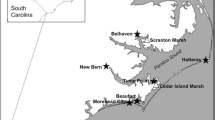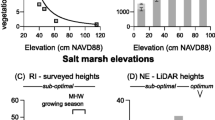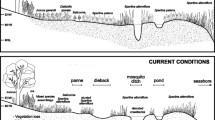Abstract
Sea-level rise is leading to the migration of marshes into coastal forests throughout North America. Marsh migration represents a primary mechanism for marsh survival in the face of sea-level rise and leads to a fundamental reorganization of vegetation communities. Yet, the ecological implications of these changes remain unknown. To evaluate the effect of marsh migration on ecosystem function, we compared habitat, primary production, vertical accretion, nutrient cycling, and carbon accumulation between new and old salt marsh on Goodwin Island (Virginia, USA) where salt marsh is migrating landward into rapidly retreating coastal forest. Using historical imagery and radioisotopic dating of sediment cores, we determined marsh age (< 3 to approximately 616 years) across the landscape. We found that salt marsh functions generally depended more on elevation and/or landscape position than marsh age. Primary production and nutrient cycling (%C and %N soil content) did not vary significantly with marsh age. Accretion and carbon accumulation rates varied predictably with elevation in old marsh but not in new marsh. Instead, trends in soil formation were controlled by the colonization of Phragmites australis, a dominant plant in migrating marsh-forest boundaries along the Atlantic Coast. Vegetation zonation patterns were more clearly defined in old marsh, indicating that habitat types take time to develop. However, these vegetation differences did not translate to consistently different ecological functions. These observations suggest that marsh migration does not lead to permanent differences in ecological functions between new and old marsh, rather ecological functions will converge as new marsh ages.








Similar content being viewed by others
References
Abbott KM, Elsey-Quirk T, DeLaune RD. 2019. Factors influencing blue carbon accumulation across a 32-year chronosequence of created coastal marshes. Ecosphere 10:e02828.
Adams DA. 1963. Factors influencing vascular plant zonation in North Carolina salt marshes. Ecology 44:445–456.
Amsberry L, Baker MA, Ewanchuk PJ, Bertness MD. 2000. Clonal integration and the expansion of Phragmites australis. Ecol Appl 10:1110–1118.
Ballantine K, Schneider R. 2009. Fifty-five years of soil development in restored freshwater depressional wetlands. Ecol Appl 19:1467–1480.
Bertness MD. 1991. Zonation of Spartina patens and Spartina alterniflora in New England salt marsh. Ecology 72:138–148.
Bertness MD, Ellison AM. 1987. Determinants of pattern in a New England salt marsh plant community. Ecol Monogr 57:129–147.
Borchert SM, Osland MJ, Enwright NM, Griffith KT. 2018. Coastal wetland adaptation to sea level rise: quantifying potential for landward migration and coastal squeeze. J Appl Ecol 55:2876–2887.
Burden A, Garbutt A, Evans CD. 2019. Effect of restoration on saltmarsh carbon accumulation in Eastern England. Biol Lett 15:20180773.
Chambers RM, Meyerson LA, Saltonstall K. 1999. Expansion of Phragmites australis into tidal wetlands of North America. Aquat Bot 64:261–273.
Chambers RM, Osgood DT, Bart DJ, Montalto F (2003). Phragmites australis invasion and expansion in tidal wetlands: interactions among salinity, sulfide, and hydrology. In: Estuaries, Vol. 26, Estaurine Research Federation, pp 398–406.
Chambers RM, Gorsky AL, Isdell RE, Mitchell MM, Bilkovic DM. 2021. Comparison of nutrient accrual in constructed living shoreline and natural fringing marshes. Ocean Coastal Manag 199:105401.
Craft C, Reader J, Sacco JN, Broome SW. 1999. Twenty-five years of ecosystem development of constructed Spartina alterniflora (Loisel) marshes. Ecol Appl 9:1405–1419.
Craft C, Broome S, Campbell C. 2002. Fifteen years of vegetation and soil development after brackish-water marsh creation. Restor Ecol 10:248–258.
Craft C, Clough J, Ehman J, Joye S, Park R, Pennings S, Guo H, Machmuller M. 2009. Forecasting the effects of accelerated sea-level rise on tidal marsh ecosystem services. Front Ecol Environ 7:73–78.
Donnelly JP, Bertness MD. 2001. Rapid shoreward encroachment of salt marsh cordgrass in response to accelerated sea-level rise. Proc Natl Acad Sci USA 98:14218–14223.
Edwards KR, Proffitt CE. 2003. Comparison of wetland structural characteristics between created and natural salt marshes in southwest Louisiana, USA. Wetlands 23:344–356.
Enwright NM, Griffith KT, Osland MJ. 2016. Barriers to and opportunities for landward migration of coastal wetlands with sea-level rise. Front Ecol Environ 14:307–316.
Fagherazzi S, Anisfeld SC, Blum LK, Long EV, Feagin RA, Fernandes A, Kearney WS, Williams K. 2019. Sea level rise and the dynamics of the marsh-upland boundary. Front Environ Sci 7:25.
Feagin RA, Sherman DJ, Grant WE. 2005. Coastal erosion, global sea-level rise, and the loss of sand dune plant habitats. Front Ecol Environ 3:359–364.
Friedrichs CT, Perry JE. 2001. Tidal salt marsh morphodynamics: a synthesis. J Coast Res 27:7–37.
Gabler CA, Osland MJ, Grace JB, Stagg CL, Day RH, Hartley SB, Enwright NM, From AS, McCoy ML, McLeod JL. 2017. Macroclimatic change expected to transform coastal wetland ecosystems this century. Nat Climate Change 7:142–147.
Gedan KB, Kirwan ML, Wolanski E, Barbier EB, Silliman BR. 2011. The present and future role of coastal wetland vegetation in protecting shorelines: answering recent challenges to the paradigm. Climatic Change 106:7–29.
Goldberg ED. 1963. Geochronology with 210Pb. In: Radioactive Dating, VIenna: International Atomic Energy Agency, pp 121–31.
Harley CDG, Hughes AR, Hultgren KM, Miner BG, Sorte CJB, Thornber CS, Rodriguez LF, Tomanek L, Williams SL. 2006. The impacts of climate change in coastal marine systems. Ecol Lett 9:228–241.
Harrison EZ, Bloom AL. 1977. Sedimentation rates on tidal salt marshes in Connecticut. J Sedimen Res 47:1484–1490.
Hill TD, Anisfeld SC. 2015. Coastal wetland response to sea level rise in Connecticut and New York. Estuarine Coast Shelf Sci 163:185–193.
IPCC. 2013. In: TF, Qi D, Plattne G-K, Tignor M, Allen SK, Boschung J, Nauels A, Xia Y, Bex V, Midgley PM Eds. Climate change 2013: the physical science basis. Contribution of working group i to the fifth assessment report of the intergovernmental panel on climate change. Stocker.
Kirwan ML, Gedan KB. 2019. Sea-level driven land conversion and the formation of ghost forests. Nature Climate Change 9:450–457.
Kirwan ML, Megonigal JP. 2013. Tidal wetland stability in the face of human impacts and sea-level rise. Nature 504:53–60.
Kirwan ML, Temmerman S, Skeehan EE, Guntenspergen GR, Fagherazzi S. 2016a. Overestimation of marsh vulnerability to sea level rise. Nat Climate Change 6:253–260.
Kirwan ML, Walters DC, Reay WG, Carr JA. 2016b. Sea level driven marsh expansion in a coupled model of marsh erosion and migration. Geophys Res Lett 43:4366–4373.
Krull K, Craft C. 2009. Ecosystem development of a sandbar emergent tidal marsh, Altamaha River Estuary, Georgia, USA. Wetlands 29:314–322.
Langston AK, Kaplan DA, Putz FE. 2017. A casualty of climate change? Loss of freshwater forest islands on Florida’s Gulf Coast. Global Change Biol 23:5383–5397.
Lindau CW, Hossner LR. 1981. Substrate characterization of an experimental marsh and three natural marshes. Soil Sci Soc Am J 45:1171–1176.
Marani M, Da Lio C, D’Alpaos A. 2013. Vegetation engineers marsh morphology through multiple competing stable states. Proc Natl Acad Sci USA 110:3259–3263.
Morris JT, Sundareshwar PV, Nietch CT, Kjerfve B, Cahoon DR. 2002. Responses of coastal wetlands to rising sea level. Ecology 83:2869–2877.
NOAA. 2016. NOAA Shoreline Website: NOAA Historical Surveys (T-Sheets).
Odum EP. 1969. The strategy of ecosystem development. Science 164:262–270.
Orson RA. 1999. A paleoecological assessment of Phragmites australis in New England tidal marshes: changes in plant community structure during the last few millennia. Biol Invas 1:149–158.
Osgood DT, Zieman JC. 1993. Spatial and temporal patterns of substrate physicochemical parameters in different-aged barrier island marshes. Estuarine Coast Shelf Sci 37:421–436.
Osgood D, Santos M, Zieman J. 1995. Sediment physico-chemistry associated with natural marsh development on a storm-deposited sand flat. Mar Ecol Prog Ser 120:271–283.
Osland MJ, Feher LC, Spivak AC, Nestlerode JA, Almario AE, Cormier N, From AS, Krauss KW, Russell MJ, Alvarez F, Dantin DD, Harvey JE, Stagg CL. 2020. Rapid peat development beneath created, maturing mangrove forests: ecosystem changes across a 25-year chronosequence. Ecol Appl 30:e02085.
Ouyang X, Lee SY. 2014. Updated estimates of carbon accumulation rates in coastal marsh sediments. Biogeosciences 11:5057–5071.
Pecl GT, Araújo MB, Bell JD, Blanchard J, Bonebrake TC, Chen I-C, Clark TD, Colwell RK, Danielsen F, Evengård B, Falconi L, Ferrier S, Frusher S, Garcia RA, Griffis RB, Hobday AJ, Janion-Scheepers C, Jarzyna MA, Jennings S, Lenoir J, Linnetved HI, Martin VY, McCormack PC, McDonald J, Mitchell NJ, Mustonen T, Pandolfi JM, Pettorelli N, Popova E, Robinson SA, Scheffers BR, Shaw JD, Sorte CJB, Strugnell JM, Sunday JM, Tuanmu M-N, Vergés A, Villanueva C, Wernberg T, Wapstra E, Williams SE. 2017. Biodiversity redistribution under climate change: impacts on ecosystems and human well-being. Science 355:9214.
Pennings SC, Callaway RM. 1992. Salt marsh plant zonation: the relative importance of competition and physical factors. Ecology 73:681–690.
Pennings SC, Grant M-B, Bertness MD. 2005. Plant zonation in low-latitude salt marshes: disentangling the roles of flooding, salinity and competition. Journal of Ecology 93:159–167.
Perry JE, Atkinson RB. 1997. Plant diversity along a salinity gradient of four marshes on the York and Pamunkey Rivers in Virginia. Castanea 62:112–118.
Raabe EA, Stumpf RP. 2016. Expansion of Tidal Marsh in Response to Sea-Level Rise: Gulf Coast of Florida, USA. Estuaries Coasts 39:145–157.
Reed DJ. 1995. The response of coastal marshes to sea-level rise: survival or submergence? Earth Surf Process Landf 20:39–48.
Rice D, Rooth J, Stevenson JC. 2000. Colonization and expansion of Phragmites australis in upper Chesapeake Bay tidal marshes. Wetlands 20:280–299.
Rooth JE, Stevenson JC. 2000. Sediment deposition patterns in Phragmites australis communities: Implications for coastal areas threatened by rising sea-level. Wetl Ecol Manag 8:173–183.
Rooth JE, Stevenson JC, Cornwell JC. 2003. Increased sediment accretion rates following invasion by Phragmites australis: the role of litter. Estuaries 26:475–483.
Scavia D, Field JC, Boesch DF, Buddemeier RW, Burkett V, Cayan DR, Fogarty M, Harwell MA, Howarth RW, Mason C, et al. 2002. Climate change impacts on US coastal and marine ecosystems. Estuaries 25:149–164.
Schieder NW, Kirwan ML. 2019. Sea-level driven acceleration in coastal forest retreat. Geology 47:1151–1155.
Schieder NW, Walters DC, Kirwan ML. 2018. Massive upland to wetland conversion compensated for historical marsh loss in Chesapeake Bay, USA. Estuaries Coasts 41:940–951.
Schuerch M, Spencer T, Temmerman S, Kirwan ML, Wolff C, Lincke D, McOwen CJ, Pickering MD, Reef R, Vafeidis AT, Hinkel J, Nicholls RJ, Brown S. 2018. Future response of global coastal wetlands to sea-level rise. Nature 561:231–234.
Shaffer GP, Wood WB, Hoeppner SS, Perkins TE, Zoller J, Kandalepas D. 2009. Degradation of Baldcypress-Water Tupelo Swamp to Marsh and Open Water in Southeastern Louisiana, USA: an Irreversible Trajectory? J Coast Res 10054:152–165.
Silliman BR, Bertness MD. 2004. Shoreline development drives invasion of Phragmites australis and the loss of plant diversity on New England salt marshes. Conserv Biol 18:1424–1434.
Silvestri S, Defina A, Marani M. 2005. Tidal regime, salinity and salt marsh plant zonation. Estuarine Coast Shelf Sci 62:119–130.
Smith JAM. 2013. The role of phragmites australis in mediating inland salt marsh migration in a mid-atlantic estuary. PLoS ONE 8:65091.
Smith SM. 2014. Vegetation change in salt marshes of Cape Cod National Seashore (Massachusetts, USA) between 1984 and 2013. Wetlands 35:127–136.
USGS. 2016. USGS Earth Explorer.
White E, Kaplan D. 2017. Restore or retreat? Saltwater intrusion and water management in coastal wetlands. Ecosyst Health Sustain 3:e01258.
Wijte AHBM, Gallagher JL. 1996a. Effect of oxygen availability and salinity on early life history stages of salt marsh plants. I. Different germination strategies of Spartina alterniflora and Phragmites australis (Poaceae). Am J Bot 83:1337–1342.
Wijte AHBM, Gallagher JL. 1996b. Effect of oxygen availability and salinity on early life history stages of salt marsh plants. II. Early seedling development advantage of Spartina alterniflora over Phragmites australis (Poaceae). Am J Bot 83:1343–1350.
Williams K, Ewel KC, Stumpf RP, Putz FE, Workman TW. 1999. Sea-level rise and coastal forest retreat on the west coast of Florida, USA. Ecology 80:2045–2063.
Zhang K, Douglas BC, Leatherman SP. 2004. Global warming and coastal erosion. Climatic Change 64:41–58.
Acknowledgements
We thank Scott Lerberg for his input on project development and the Chesapeake Bay National Estuarine Research Reserve for access to Goodwin Island. We thank Tyler Messerschmidt for field assistance, and Jenn Connell for processing sediment core samples. This work was supported by NSF CAREER (EAR-1654374) and NSF LTER (DEB-1832221) and the Dominion Energy Charitable Foundation (Richmond, VA). This is contribution 4013 of the Virginia Institute of Marine Science, William & Mary.
Author information
Authors and Affiliations
Corresponding author
Rights and permissions
About this article
Cite this article
Langston, A.K., Coleman, D.J., Jung, N.W. et al. The Effect of Marsh Age on Ecosystem Function in a Rapidly Transgressing Marsh. Ecosystems 25, 252–264 (2022). https://doi.org/10.1007/s10021-021-00652-6
Received:
Accepted:
Published:
Issue Date:
DOI: https://doi.org/10.1007/s10021-021-00652-6




